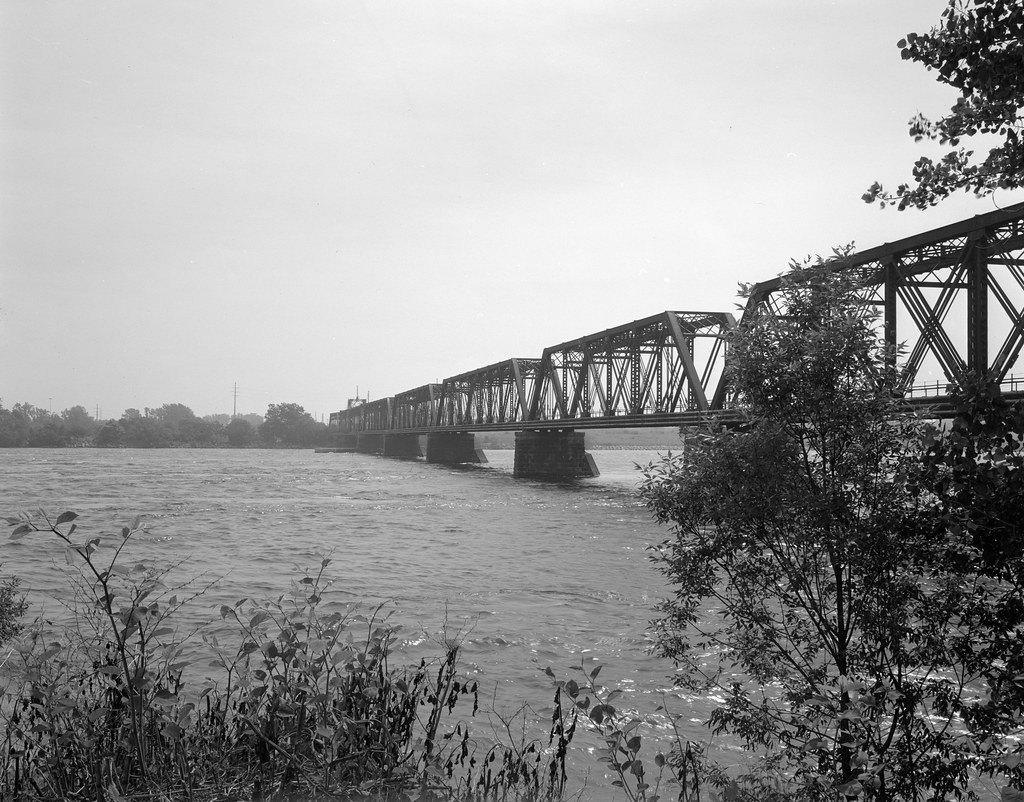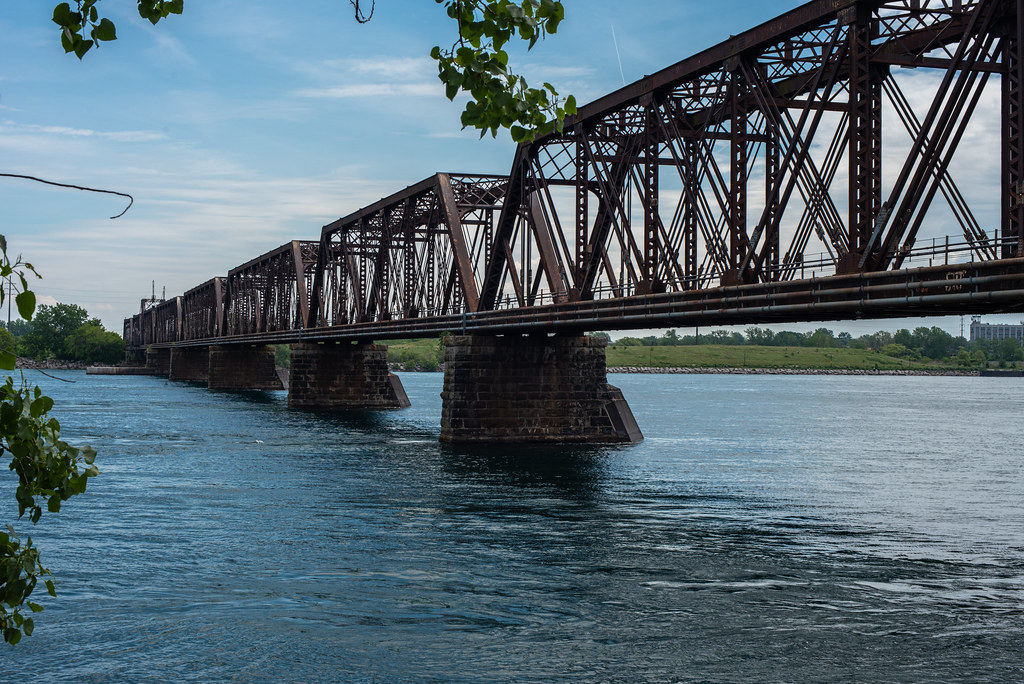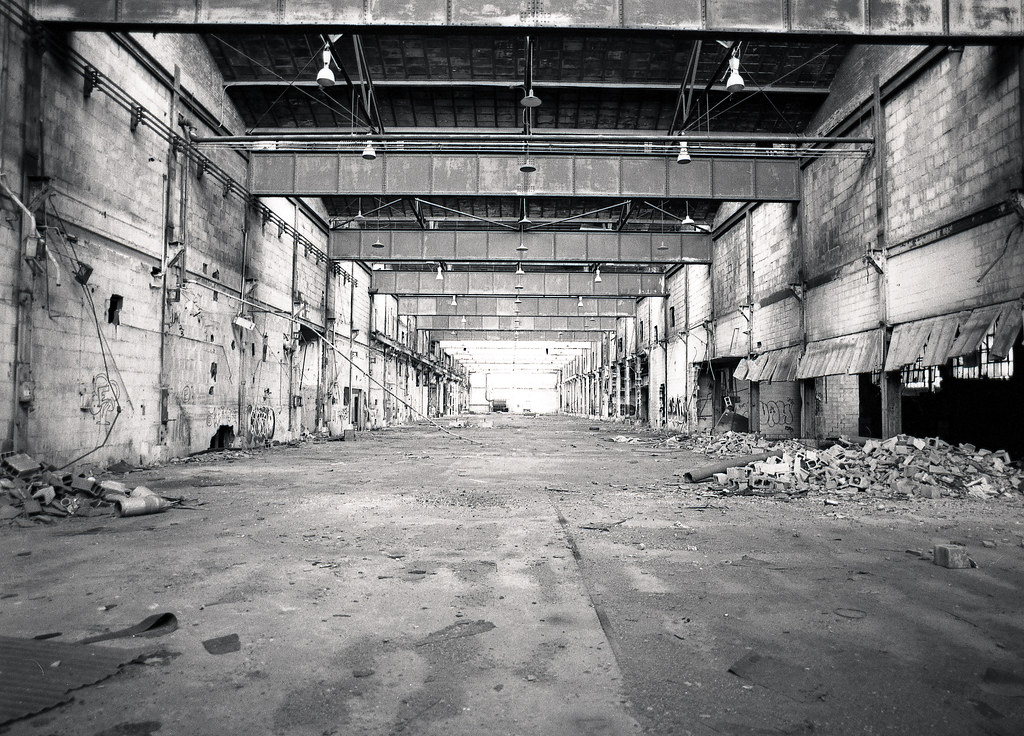The Niagara River has never been the easiest obstacle to navigate in Ontario, the main reasons being the current, the falls, and the gorge. Bridges were neither cheap nor easy to build but possible. The easiest means to get trains across the river were through the use of rail ferries. Steamships were designed to carry large numbers of cars, but the process was slow, bottlenecked the line, and there was also the tendency for ships to sink or get caught in the current and swept away.

Graflex Crown Graphic – Fuji Fujinon-W 1:5.6/125 – Ilford HP5+ @ ASA-200 – Pyrocat-HD (1+1+100) 9:00 @ 20C
All major operators initially used rail ferries, while Buffalo & Lake Huron had the easiest route between Fort Erie and Buffalo. With their line’s terminus at Niagara Falls, Great Western Railway required rerouting the train to Queenston for loading and unloading. So they were one of the first to start planning a railway bridge. But Great Western wasn’t planning any railway bridge; they aimed to build a suspension bridge. Working with William Hamilton Merritt, the bridge opened to traffic in 1855, supporting two levels, one for a single railway track and a second for foot and carriage traffic. When it opened, it was not only Canada’s first but the world’s first railway suspension bridge. The suspension wires were supported by four twenty-seven meter tall Egyptian inspired pillars, work being done by a young Scottish stonemason William Henderson. But above the falls, the Buffalo & Lake Huron Railway continued to use the rail ferry International but had planned by 1856 for their own bridge between Fort Erie and Black Rock. But having no real financial stability, the plans remained on paper. As Grand Trunk began to take on more operational control over Buffalo & Lake Huron, the new operator furthered plans. Grand Trunk had completed their first rail bridge over the Grafraxa River in Port Hope and their biggest bridge, the Victoria Bridge in Montreal, over the St. Lawerence River in 1860. By 1864 representatives of New York State and the Province of Canada signed an agreement to have a bridge completed between Fort Erie and Black Rock. When the American Civil War opened, the plans were shelved and remained that way in the serious dip in Anglo-American relations during and following the war. The Fenian Raids of 1866 did not help matters either. The International being requested by the Canadian Militia as an armed gunboat and a means to move troops by the Fenians. It remained safely in the middle of the river, refusing to move, having been ordered to stay put by Grand Trunk employees.

Nikon D750 – AF Nikkor 50mm 1:1.4D
Nikon D300 – AF-S Nikkor 70-200mm 1:2.8G
Thankfully the relations warmed by the end of the decade, and plans were again coming together. In 1870, the Canadian Bridge Company and American Bridge Company chartered the International Bridge Company to construct the proposed bridge. C.S. Gzowski & Co. won the contract from International Bridge to complete the main piers and final assembly construction. At the same time, the bridge steel and sections went to Phoenix Iron Works in Pennsylvania. The bridge would span the shortest section of the river but far from ideal. At this point, the river depth stood at fourteen meters, and the current flowed at nineteen kilometres per hour. The continued damage from ice broke away from Lake Erie and flowed down to Niagara Falls that could prove dangerous to the piers. Construction began in 1871 with dredging three metres of gravel from the river bed. The eight piers that secured the bridge across the river were constructed from locally quarried limestone and designed to break up ice flows rather than have them dashed against them. Phoenix Ironworks constructed the bridge portions in twelve sections using a standard Baldwin Truss pattern. Each section was floating in, raised on special pontoons and secured in place. While the Canadian side of the bridge was fixed, the American side featured two swing sections. The sections were around Unity Island, allowing ships to still access the harbours at Black Rock and Buffalo. A single railway track crossed the bridge, and a separate section allowed for pedestrian traffic. During the construction, not a single life was lost, or the accident delayed the effort. When the bridge was completed, it had cost 1.5 million dollars and spanned 1113 metres. And railway traffic stood ready to make use of the new bridge when it opened on the 3rd of November 1873; present at the ceremony were Grand Trunk President Richard Potter and Internation Bridge Co-President Matthew Brydges. While Grand Trunk trains used the bridge without trouble, all other operators had to pay a fee at a dollar per car. While most operators had no issues paying the toll rather than spend the money needed to build their own bridge, Canadian Southern sued Grand Trunk.

Mamiya m645 – Mamiya-Sekor C 45mm 1:2.8 N – Ilford FP4+ @ ASA-100 – Kodak D-23 (Stock) 6:00 @ 20C
Pentax 645 – SMC Pentax A 645 35mm 1:3.5 – Kodak Tri-X 400 @ ASA-400 – Kodak HC-110 Dil. B 7:30 @ 20C
As the popularity of the railway increased, the need for larger bridges became obvious, and bridges with a single track across them were becoming obsolete. Grand Trunk completed a new bridge in 1897, the Whirlpool Bridge, to replace the original Niagara Suspension Bridge. And in 1900, the International Railway Bridge was revamped, removing the original bridge sections and replacing them with one that supported two tracks at the cost of the pedestrian walkway. Three years later, baseball player Ed Delany who had been removed from a train for being drunk, attempted to cross the bridge on foot, dying. While always a busy crossing, the busiest day of the bridge took place on the 10th of July 1916 when 264 trains crossed the bridge. Canadian National took over operations on the bridge in 1923 when Grand Trunk Railway was absorbed into the new company. In 1929, Michigan Central, which was now in complete control of Canadian Southern, completed their own bridge at Niagara Falls. Passenger services across the bridge dwindled with the final Canadian National Passenger train crossing in 1934. The Americans disabled one of the swing sections on their bridge in 1941. The bridge had spent a great deal of its operational life without closure, at least until 1993. Canadian National was forced to close the bridge due to emergency repairs to several of the support piers, which were still original to 1873; the repairs cost two million but ensured the continued use of the bridge. Further updates to the bridge decking took place in 2000. Today, the International Railway Bridge remains the oldest operational railway bridge in Ontario, far from the original. Its construction pre-dates many of the original bridges constructed by the Canadian Pacific through the Rockies. Many of the older Grand Trunk Bridges have been either totally replaced or modified far beyond the original to be considered original. It is also one of two operational railway bridges across the Niagara River, the 1897 Whirlpool Bridge as the Michigan Central bridge shut down in 2001. On average, the bridge sees fifteen trains daily crossing.